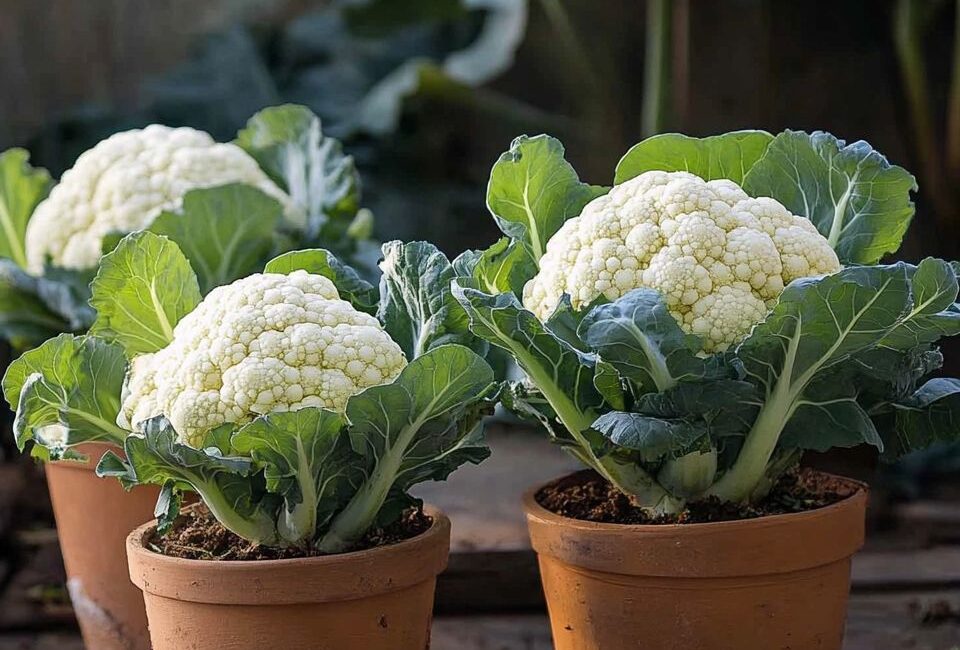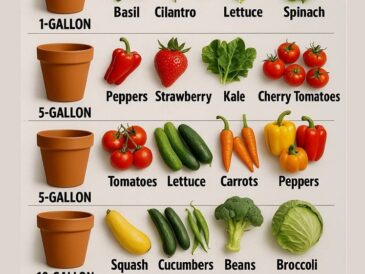To encourage large cauliflower heads, it’s important to care for your plants regularly. Here’s what you need to do:
a. Thinning the Plants
If you’ve seeded multiple plants or bought several seedlings, you’ll need to thin out the weaker ones and keep only the strongest. This will allow the remaining plants to grow to their full potential.
b. Providing Support
As cauliflower plants grow, their heads can become heavy. You may need to support the plants with bamboo stakes or other structures to prevent them from falling under their own weight.
7. Watering Cauliflower in Pots
Cauliflower requires a relatively high water intake, especially as it grows and begins to form its heads. Proper watering is essential for plant health. Here are some watering tips:
a. Maintain Constant Moisture
Cauliflower likes consistent moisture in the soil but does not like to be waterlogged. Water deeply to keep the soil moist but not soggy.
b. Avoid Wetting the Leaves
Water directly at the soil level, avoiding wetting the leaves. Wet leaves can promote fungal diseases.
c. Deep Watering
It’s better to water deeply rather than in small, frequent doses. This encourages the roots to grow deeper, making the plant more robust.
8. Fertilizing Cauliflower for Maximum Growth
Cauliflower is a heavy feeder, so it requires regular fertilization. Here’s what you need to know about fertilizing your cauliflower:
a. Use Balanced Fertilizer
Choose a balanced fertilizer with equal proportions of nitrogen, phosphorus, and potassium (like a 10-10-10). Nitrogen promotes leaf growth, phosphorus supports root development, and potassium strengthens the overall health of the plants.
b. Organic Fertilizers
If you prefer organic methods, compost or liquid fertilizers such as fish emulsion or seaweed extract are excellent choices. Apply these fertilizers every 2 to 4 weeks during the growing season.
c. Avoid Over-Fertilizing
Although cauliflower is a heavy feeder, over-fertilizing can lead to excessive leaf growth at the expense of the head. Stick to the recommended amounts.
9. Light Requirements for Growing Cauliflower
Cauliflower requires plenty of light to grow well. Here are some tips to maximize sunlight exposure:
a. Full Sun Exposure
Cauliflower needs at least 6 hours of direct sunlight per day. A sunny patio or balcony is ideal. If you don’t have full sun, choose a spot that gets at least 4 to 5 hours of direct sunlight per day.
b. Avoid Excessive Heat
While cauliflower loves the sun, it prefers cool temperatures. If you live in a hot climate, ensure your pot is placed in
a location where it can get morning sunlight and is shaded in the afternoon.
10. Managing Pests and Diseases
Cauliflower plants are susceptible to various pests and diseases. Here are some common issues to watch for:
a. Aphids and Whiteflies
These pests suck sap from the plant, weakening it. Use neem oil or insecticidal soap to treat infestations.
b. Cabbage Worms
These caterpillars can devour cauliflower leaves. Handpick them off or use organic diatomaceous earth around the base of the plant to deter them.
c. Fungal Diseases
Fungal diseases like powdery mildew and downy mildew can affect cauliflower. Ensure good airflow around the plant and remove any affected leaves.
11. How to Encourage the Formation of Bigger Cauliflower Heads
To grow the largest cauliflower, ensure the following:
a. Consistent Care
Provide consistent care, including proper watering, fertilizing, and pest control.
b. Temperature Control
Cauliflower thrives in cool temperatures, so aim for 60-65°F (15-18°C). If the temperatures rise above 80°F (27°C), cauliflower may bolt or stop forming a head.
c. Blanching the Heads
To promote the development of a large, white cauliflower head, blanch it by tying the leaves together over the head once it starts forming. This protects it from sunlight and ensures that the head remains tender and white.
12. Harvesting Cauliflower
Cauliflower heads are ready to harvest when they are dense, firm, and fully formed. Typically, this occurs around 2-3 months after planting. When harvesting:
- Use a sharp knife to cut the cauliflower head off at the base.
- Leave a small portion of the stem attached to the head for easier handling.
13. Solving Common Cauliflower Problems
a. Small Heads
If your cauliflower heads are too small, it could be due to insufficient space in the pot or lack of nutrients. Ensure your pot is large enough and your plants are getting proper nutrition.
b. Bolting
If cauliflower starts to flower prematurely, this is known as bolting. Bolting can occur due to high temperatures. Move your pot to a cooler location to prevent this.
14. Conclusion: Tips for Growing a Giant Cauliflower
Growing a giant cauliflower in a pot is entirely achievable with the right care and attention. By choosing the right variety, providing ample space for the roots, and following a consistent care routine, you can grow cauliflower heads that are both large and healthy.




